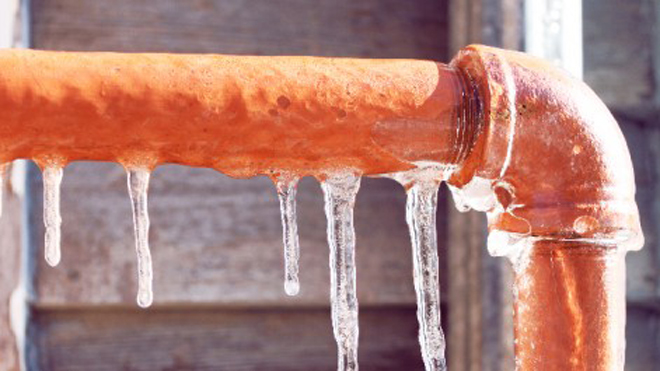They are making a number of good observations on Prevent Frozen Pipes in general in the article down below.

Winter can ruin your plumbing, particularly by freezing pipes. Below's exactly how to prevent it from happening and what to do if it does.
Introduction
As temperature levels decrease, the threat of icy pipes boosts, possibly bring about pricey repairs and water damages. Recognizing just how to stop frozen pipelines is essential for property owners in cool climates.
Understanding Frozen Pipes
What creates pipes to freeze?
Pipelines freeze when exposed to temperature levels listed below 32 ° F (0 ° C) for expanded durations. As water inside the pipelines freezes, it broadens, taxing the pipe wall surfaces and potentially creating them to burst.
Risks and damages
Frozen pipelines can result in supply of water interruptions, residential property damages, and expensive repair work. Burst pipelines can flood homes and create considerable structural damage.
Indicators of Frozen Piping
Identifying icy pipes early can stop them from bursting.
Exactly how to determine frozen pipes
Try to find reduced water flow from faucets, uncommon smells or sounds from pipes, and visible frost on exposed pipes.
Avoidance Tips
Insulating at risk pipes
Wrap pipes in insulation sleeves or make use of warm tape to shield them from freezing temperatures. Concentrate on pipelines in unheated or outside locations of the home.
Heating methods
Keep indoor rooms appropriately heated, specifically locations with plumbing. Open closet doors to allow cozy air to circulate around pipes under sinks.
Protecting Exterior Plumbing
Garden hose pipes and outside faucets
Disconnect and drain pipes yard pipes before winter months. Set up frost-proof faucets or cover exterior taps with shielded caps.
What to Do If Your Pipes Freeze
Immediate actions to take
If you presume icy pipelines, maintain taps open to ease pressure as the ice melts. Make use of a hairdryer or towels taken in hot water to thaw pipelines slowly.
Long-Term Solutions
Architectural changes
Think about rerouting pipelines far from exterior wall surfaces or unheated areas. Add added insulation to attics, cellars, and crawl spaces.
Upgrading insulation
Invest in top notch insulation for pipes, attic rooms, and walls. Proper insulation helps maintain regular temperature levels and decreases the danger of frozen pipelines.
Final thought
Avoiding frozen pipelines requires positive measures and quick feedbacks. By comprehending the reasons, indications, and preventive measures, property owners can protect their plumbing throughout cold weather.
6 Proven Ways to Prevent Frozen Pipes and Protect Your Home
Disconnect and Drain Garden Hoses
Before winter arrives, start by disconnecting your garden hoses and draining any remaining water. Close the shut-off valves that supply outdoor hose bibs and leave the outdoor faucet open to allow any residual water to drain. For extra protection, consider using faucet covers throughout the colder months. It’s also important to drain water from any sprinkler supply lines following the manufacturer’s directions.
Insulate Exposed Pipes
Insulating your pipes is an effective way to prevent freezing. Pipe insulation is readily available at home improvement stores and is relatively inexpensive. Pay close attention to pipes in unheated areas such as the attic, basement, crawl spaces, or garage. Apply foam insulation generously to create a buffer against the cold. You can also wrap your pipes in heat tape or thermostat-controlled heat cables for added warmth.
Seal Air Leaks
Inspect your home for any cracks or openings that could let in cold air. Seal any holes around the piping in interior or exterior walls, as well as the sill plates where your home rests on its foundation. Additionally, make sure to keep your garage door closed unless you’re entering or exiting. Leaving it open creates a significant air leak that can lead to frozen pipes.
Allow Warm Air Circulation
During cold snaps, it’s essential to allow warm air to circulate evenly throughout your home. Leave interior doors ajar to promote better airflow. Open kitchen and bathroom cabinets to help distribute heat consistently around the rooms. If you have small children or pets, be sure to remove any household chemicals or potentially harmful cleaners from open cabinets for safety.
Let Faucets Drip
A small trickle of water can make a big difference in preventing ice formation inside your pipes. When temperatures drop significantly, start a drip of water from all faucets served by exposed pipes. This continuous flow helps prevent the water from freezing. Additionally, running a few faucets slightly can relieve pressure inside the pipes, reducing the chances of a rupture if the water inside does freeze.
https://choateshvac.com/6-proven-ways-to-prevent-frozen-pipes-and-protect-your-home/

We had been made aware of that editorial about Preventing and dealing with frozen pipes from someone on our other domain. In case you enjoyed reading our post please remember to share it. Thank you for being here. Don't forget to check up our site back soon.
Visit Url
Comments on “How to Defend Your Plumbing from Freezing: Key Advice”